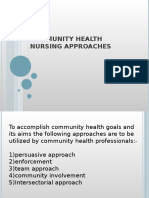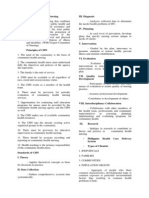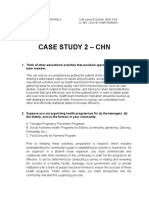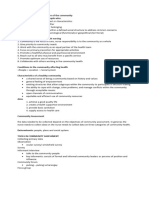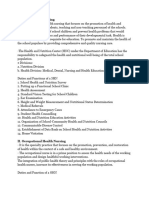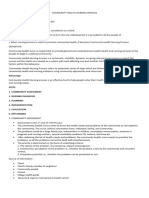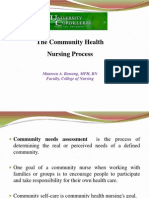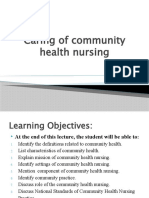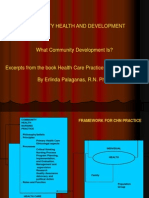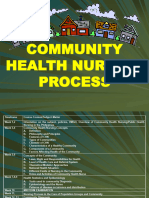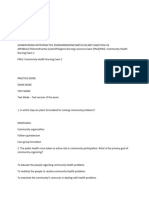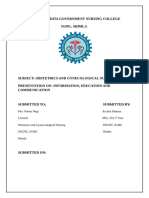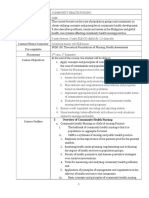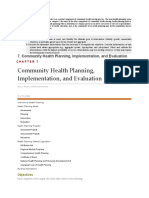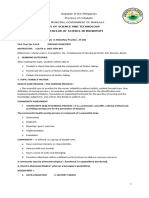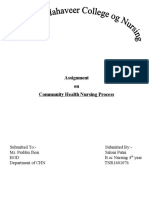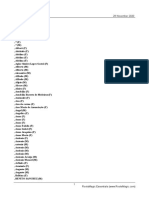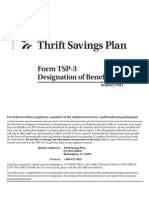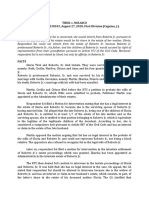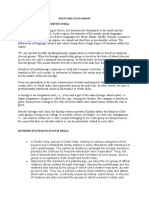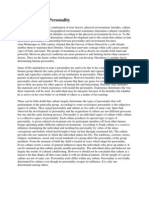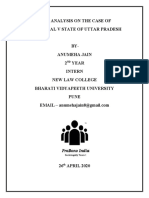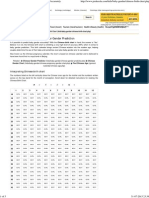Balite
Balite
Uploaded by
Raymond Lee Montilla BaliteCopyright:
Available Formats
Balite
Balite
Uploaded by
Raymond Lee Montilla BaliteCopyright
Available Formats
Share this document
Did you find this document useful?
Is this content inappropriate?
Copyright:
Available Formats
Balite
Balite
Uploaded by
Raymond Lee Montilla BaliteCopyright:
Available Formats
Name: Kyziah Lyn M. Balite 1. Discuss the comprehensive community diagnosis.
N107
Comprehensive Community Diagnosis is more focused on obtaining general information about the community. It takes the community as a whole and gives emphasis on all of its aspects, its strengths and weaknesses. The prioritizing of the health problems will just come later on in the process. Here, youll have to research about the communitys demographical data, the socio-economic and cultural variables affecting health, the economic status of the community, the status of the communitys environment, the health and illness patterns, the health resources including health manpower and material resources, and the political and leadership patterns. Youll have to look at a whole bunch of factors and see how they figure into the health status of the people. Youll have to relate everything from how politics affect the peoples health to how their culture affects their health. It encompasses all the aspects of the communitys health and looks at it from all possible perspectives. Of course, this cannot be done in a short time, meaning that nurses who plan to make a comprehensive nursing diagnosis have to expect that they will have to dedicate much of their time on this. 2. What are the phases of community diagnosis? Explain each. a. Determine the Objectives whether a comprehensive or a problem oriented community diagnosis will be undertaken by the nurse and community, it is critical to determine the occurrence and distribution of selected environmental, socio-economic and behavioral conditions. b. Defining the Studying Population the nurse and the community diagnosis team identify the population group to be included in the study. c. Determining the Data to be Collected- after the objectives and the study population have been defined the nurse together with the community members need to figure out a skim to rationalize the relevant to be obtained. Data can be categorized as primary and secondary based on the source. d. Collecting the Data the nurse decides on the specific methods depending on the type of data to be generated. Methods to collect data through observation, records review, interview and focus group discussion. e. Developing the Instruments instruments or tools facilitate the nurse data gathering facilities. The nurse uses most instruments in her data collection, survey questionnaire, focus group discussion guide, key informant interview guide and observation checklist. f. Actual Data Gathering- the nurse supervises the data collectors by checking the filled up instruments in terms of completeness, accuracy and reliability of information collected. g. Data Collation- after data collection, the nurse and the team are now ready to put together all facts and figures to generate information about the health status of the community, 2 types of data are generated either NUMERICAL or DESCRIPTIVE DATA h. Data Presentation- will depend largely on the type of data obtained. Descriptive data are presented in narrative reports and numerical data maybe presented into table or graphs.
i.
Data Analysis-most crucial stage in community diagnosis. It involves quantification, description and classification of data j. Identifying the Community Health Nursing Problems- defining the community health nursing problems will help the nurse and the team to decide with the people what actions will effectively address and improve communitys health. Community health nursing problems are categorized as health status problems, health resources problems and health related problems. k. Priority Setting- the nurse and the community is to prioritize which health problems can be attended to considering available resources, limitations and constraints. 3. Differentiate health problem with nursing problem. Give one example each. Health Problem. These refers to health deficits that are diagnosed or not, health threats or foreseeable crisis identified during the assessment process. Example: Malnutrition Nursing problem. Inability to recognize the presence of a problem due to ignorance about the facts of the condition. Example: Unable to recognize the presence of a malnutrition due to ignorance about the facts its condition. 4. Using the criteria in identifying problem and prioritizing compute 3rd degree malnutrition. CRITERIA WEIGHT 1. Nature of the condition or problems presented Scale ** wellness state Health deficit 3 1 Health threat Foreseeable crisis 2. Modifiability of the condition Scale **easily modifiable 2 2 Partially modifiable Not modifiable 3. Preventive potential Scale**High 3 1 Moderate Low 4. Salience Scale**a condition or problem, needing immediate attention a condition or problem not needing immediate attention 1 1
not perceived as a problem or condition needing change Solution: 1. 3/3 x 1 = 1 2. 2/2 x 2 = 2 3. 3/3 x 1 = 1 4. 1/2 x 1 = 0.5 Total: 1+2+1+0.5 = 4.5 3rd degree malnutrition has highest priority 5. Discuss the phases of community organizing. a. Pre-entry Phase. Is the initial phase of the organizing process where the community/organizer looks for communities to serve/help. It is considered the simplest phase in terms of actual outputs, activities and strategies and time spent for it. b. Entry Phase. Sometimes called the social preparation phase as to the activities done here includes the sensitization of the people on the critical events in their life, innovating them to share their dreams and ideas on how to manage their concerns and eventually mobilizing them to take collective action on these. This phase signals the actual entry of the community worker/organizer into the community. She must be guided by the following guidelines however. Recognizes the role of local authorities by paying them visits to inform them of their presence and activities. The appearance, speech, behavior and lifestyle should be in keeping with those of the community residents without disregard of their being role models. Avoid raising the consciousness of the community residents; adopt a low-key profile. c. Organization Building Phase. Entails the formation of more formal structures and the inclusion of more formal procedures of planning, implementation, and evaluating community-wide activities. It is at this phase where the organized leaders or groups are being given trainings (formal, informal, OJT) to develop their skills and in managing their own concerns/programs. d. Sustenance and Strengthening Phase .Occurs, when the community organization has already been established and the community members are already actively participating in community-wide undertakings. At this point, the different communities setup in the organization building phase are already expected to be functioning by way of planning, implementing and evaluating their own programs with the overall guidance from the community-wide organization. 6. What are the importance of community participation? Develop the capability to assume greater responsibility for assessing their health needs and problems. Plan and act to implement their solutions Create and maintain organization in support of these efforts and
Evaluate the effects and bring about necessary adjustments in goals and collective action
7. Explain the basic health services offered by the government in the community. I. Maternal Health Program The Philippines is tasked to reduce the maternal mortality ratio (MMR) by three quarters by 2015 to achieve its millennium development goal. This means a MMR of 112/100,000 live births in 2010 and 80/100,000 live births by 2015. However, the Philippines find it hard to reduce maternal mortality. Similarly, perinatal mortality reduction has been minimal. ANTENATAL REGISTRATION * Every women has to visit the nearest health facility for antenatal registration and to avail prenatal care services. This is the only way to guide her in pregnancy care to make her prepared for childbirth. B. TETANUS TOXOID IMMUNIZATION * Both mother and child are protected against neonatal tetanus. C. MACRONUTRIENT and MICRONUTRIENT SUPPLEMENTATION * Interventions for maternal health include supplementation for folic acid, iron, Vitamin A and balanced energy and protein intake to improve maternal and fetal outcomes. D. TREATMENT OF DISEASES and OTHER CONDITIONS * Iodine deficiency is one of the preventable cause of mental retardation and brain damage. It is also associated with cretinism, low mean birth weight and increased infant mortality. All of 4 provinces of Northern Mindanao are high-risk IDD areas. The nurse can assess the womens thyroid gland by palpation, based on the report that 30% of pregnant women have goiter. E. EARLY DETECTION AND MANAGEMENT OF COMPLICATIONS OF PREGNANCY * The nurse needs to have the skill in detecting the danger signs of pregnancy. Patients manifesting these signs need to referred to the nearest facility or physician. Interestingly, the results of the study by ADB on 41 out of 79 provinces in the Philippines show that only 56.6% of women were advised to go to specific public facilities in case of pregnancy complication. The rest were not adequately informed where they can go if they encountered pregnancy complications.
F. FAMILY PLANNING COUNSELLING * Family planning and fertility awareness are part of what is discussed in the first prenatal visit and the subsequent visits. After delivery, the benefits of family planning, risks of a pregnancy too soon and most suitable family planning methods for a breastfeeding woman are discussed. The choices offered are IUD, condom, progesterone only pill, natural family planning, spermicides and permanent methods G. STD/HIV/AIDS PREVENTION AND MAANGEMENT * The WHO standard aims for all women during pregnancy, childbirth and the postnatal period to be given appropriate information on the prevention and recognition of Sexually Transmitted Infections (STIs) and reproductive tract infections (RTIs).
You might also like
- The Addams FamilyDocument3 pagesThe Addams FamilySelcen Goger50% (2)
- Sajib eDocument1 pageSajib eJeams Dany100% (2)
- Community Health Nursing ApproachesDocument19 pagesCommunity Health Nursing Approacheshemihema100% (6)
- Court Directory (Province of Cavite)Document6 pagesCourt Directory (Province of Cavite)Ian dela Cruz Encarnacion100% (1)
- Community Health Nursing Process: Prepared By: Ma. Tonnette Aurora T. Tan, R.NDocument33 pagesCommunity Health Nursing Process: Prepared By: Ma. Tonnette Aurora T. Tan, R.NSamantha67% (3)
- The Public/Community Health Nursing ProcessDocument79 pagesThe Public/Community Health Nursing ProcessRitaNo ratings yet
- CHN HandoutDocument4 pagesCHN HandoutRaymund Christopher Dela PeñaNo ratings yet
- Community Health Nursing Approaches: Presented ByDocument19 pagesCommunity Health Nursing Approaches: Presented ByAkanksha Rathore100% (1)
- Community Health Nursing Ii NUR204: Population Groups and Community As Clients)Document31 pagesCommunity Health Nursing Ii NUR204: Population Groups and Community As Clients)ZairaNo ratings yet
- CHN Case Study 2 SampleDocument2 pagesCHN Case Study 2 SampleMary Shane MoraldeNo ratings yet
- The Nursing Process in The Care of The Community NotesDocument5 pagesThe Nursing Process in The Care of The Community NotesKylie CabatasNo ratings yet
- COPAR Community Assessment 1Document3 pagesCOPAR Community Assessment 1Winter KimNo ratings yet
- Capp Activity 2 (Operaña)Document6 pagesCapp Activity 2 (Operaña)Ellayza OperanaNo ratings yet
- Different Fields in CHN - ReportDocument8 pagesDifferent Fields in CHN - ReportSACHI DANIELLA TATOYNo ratings yet
- Community Health Nursing Overview 1Document94 pagesCommunity Health Nursing Overview 1jonaTOTNo ratings yet
- Community Health Nursing 2:: Population Groups and Community As ClientsDocument20 pagesCommunity Health Nursing 2:: Population Groups and Community As ClientsRamzen Raphael DomingoNo ratings yet
- Lab Community Health Nursing Nur 193Document6 pagesLab Community Health Nursing Nur 193Bryan Lloyd Ballestar RayatNo ratings yet
- Steps in Community Health Nursing ProcessDocument3 pagesSteps in Community Health Nursing ProcessJoemay Belle CabanelaNo ratings yet
- A. Nursing Process in The Care of Population, Groups, and CommunityDocument6 pagesA. Nursing Process in The Care of Population, Groups, and Communityanne marie67% (3)
- Community Health NursingDocument10 pagesCommunity Health NursingBunzay GelineNo ratings yet
- CHN OverviewDocument7 pagesCHN OverviewmilayosoresNo ratings yet
- CHN PresentationDocument48 pagesCHN PresentationCeceni Rose Perez PareNo ratings yet
- Community Nursing Process ModuleDocument7 pagesCommunity Nursing Process ModuleJocelle Joy OrellanedaNo ratings yet
- M 100 Health AssessmentDocument5 pagesM 100 Health AssessmentKristine Mae LoquireNo ratings yet
- Community Health Nursing ProcessDocument23 pagesCommunity Health Nursing ProcessMaureen A. Bawang0% (1)
- CHN Chapter 6Document6 pagesCHN Chapter 6Paulo Marie TanNo ratings yet
- Codes IiDocument102 pagesCodes IiJam Mohammad100% (1)
- Community Health and DevelopmentDocument48 pagesCommunity Health and Developmentabid6027307No ratings yet
- Lesson 3 - PH Health Care and PH Health Care Delivery SystemDocument4 pagesLesson 3 - PH Health Care and PH Health Care Delivery Systemsunshine bangtanNo ratings yet
- Caring of Community Health NursingDocument41 pagesCaring of Community Health NursingFatimah AlshareefNo ratings yet
- Community Phc2 RleDocument12 pagesCommunity Phc2 Rleefermin_lovely100% (1)
- Community Health and DevelopmentDocument48 pagesCommunity Health and DevelopmentDthird Mendoza ClaudioNo ratings yet
- Activity 3 Community Health EducationDocument3 pagesActivity 3 Community Health EducationKristel DolienteNo ratings yet
- CHCDocument22 pagesCHCBunti ThakurNo ratings yet
- Assessment On The Effectiveness of Adopt A Child Program in Community DevelopmentDocument17 pagesAssessment On The Effectiveness of Adopt A Child Program in Community DevelopmentjuvysobrevillaNo ratings yet
- CHN Concepts 1220707432475430 8Document48 pagesCHN Concepts 1220707432475430 8Chrysolite Cueva SalvadorNo ratings yet
- CHN2 Lecture Number 3 Final TermDocument77 pagesCHN2 Lecture Number 3 Final TermtrishzamaebNo ratings yet
- Vbook - Pub Brandon Arete Midterm Exam Question and Answer PDFDocument24 pagesVbook - Pub Brandon Arete Midterm Exam Question and Answer PDFXarius FidelNo ratings yet
- RNpedia WPS OfficeDocument12 pagesRNpedia WPS Officeguinomtadmarcos0No ratings yet
- CHN1 Worksheet1Document5 pagesCHN1 Worksheet1Chariza MayNo ratings yet
- IECDocument12 pagesIECArchita SharmaNo ratings yet
- OVERVIEW OF Public Health Nursing in The PhilippinesDocument13 pagesOVERVIEW OF Public Health Nursing in The Philippinesjanina myka100% (1)
- 2 Community Healtyh Nursing - Field in NursingDocument12 pages2 Community Healtyh Nursing - Field in NursingsannsannNo ratings yet
- WEEK 1 - Concept of CommunityDocument5 pagesWEEK 1 - Concept of Communitypoleene de leonNo ratings yet
- Community Health NursingDocument9 pagesCommunity Health NursingtheglobalnursingNo ratings yet
- CHN - JoyDocument3 pagesCHN - JoyJoy VelascoNo ratings yet
- CHN LectureDocument138 pagesCHN Lecturejonalyn urao100% (1)
- CHC Unit-2 GNMDocument22 pagesCHC Unit-2 GNMBunti ThakurNo ratings yet
- Community Health NursingDocument18 pagesCommunity Health NursingCharmagne Joci EpantoNo ratings yet
- Community Survey and DiagnosisDocument5 pagesCommunity Survey and DiagnosisJohn PaulNo ratings yet
- Prelim NotesDocument13 pagesPrelim Notesjohncarlo ramosNo ratings yet
- Chapter 3Document18 pagesChapter 3mattNo ratings yet
- Community Health Planning, Implementation, and EvaluationDocument9 pagesCommunity Health Planning, Implementation, and EvaluationKarl Angelo MontanoNo ratings yet
- Community Health NursingDocument7 pagesCommunity Health NursingRosafe E. PeraltaNo ratings yet
- CHN-2-FINALSDocument4 pagesCHN-2-FINALSbealou415No ratings yet
- Socail Mobilzation Plan Final New 2Document15 pagesSocail Mobilzation Plan Final New 2Sajad Ahmed MemonNo ratings yet
- M 100 Health Assessment BSM - 1 1Document9 pagesM 100 Health Assessment BSM - 1 1Kristine Mae LoquireNo ratings yet
- NCM 107 1Document5 pagesNCM 107 1Clint Mikael EulatrizNo ratings yet
- Learning Task CHN 1 December 2Document2 pagesLearning Task CHN 1 December 2Dawn ReyaNo ratings yet
- CHN RevDocument134 pagesCHN RevGlenn Asuncion PagaduanNo ratings yet
- Cmmty DXDocument125 pagesCmmty DXReine Chiara B. ConchaNo ratings yet
- Assignment On Community Health Nursing ProcessDocument11 pagesAssignment On Community Health Nursing ProcessMukul ThakurNo ratings yet
- 2017 Philippine NDHS Key Findings PDFDocument49 pages2017 Philippine NDHS Key Findings PDFHumanRights_PhNo ratings yet
- God, Sex, YouDocument6 pagesGod, Sex, YouElijah MathewNo ratings yet
- Permissibility of Writing On The KaffanDocument23 pagesPermissibility of Writing On The KaffanEhtesham100% (1)
- 30 UPa JIntl LDocument35 pages30 UPa JIntl Lsonam1992No ratings yet
- Name: Prencess Edwina S. Maun Form No 1: Action For Annulment of Contract Purpose of FormDocument10 pagesName: Prencess Edwina S. Maun Form No 1: Action For Annulment of Contract Purpose of FormPrincess MaunNo ratings yet
- XN Abrahan Senior - Rel IndividualDocument343 pagesXN Abrahan Senior - Rel IndividualCristiano Rodrigues do AmaralNo ratings yet
- Thrift Savings Plan: Form TSP-3Document8 pagesThrift Savings Plan: Form TSP-3widhisaputrawijayaNo ratings yet
- AP Psychology - Myers 9th Edition - Module 11 & 12 Vocab and ExamplesDocument4 pagesAP Psychology - Myers 9th Edition - Module 11 & 12 Vocab and ExamplesJaakkiiee YungNo ratings yet
- Tirol v. NolascoDocument4 pagesTirol v. NolascoLorna IlustrisimoNo ratings yet
- Divorce Case 10 of 2016Document13 pagesDivorce Case 10 of 2016wanyamaNo ratings yet
- North and South KinshipDocument2 pagesNorth and South KinshipBrinda SharmaNo ratings yet
- Adolescent Health and Development Program Manual of OperationsDocument216 pagesAdolescent Health and Development Program Manual of OperationsDoctor KenNo ratings yet
- Psychoanalytic CriticismDocument20 pagesPsychoanalytic CriticismFakhirah Ab AzizNo ratings yet
- Determinants of PersonalityDocument2 pagesDeterminants of Personalityjmcverzola1004No ratings yet
- GrimDocument13 pagesGrimSindhu NairNo ratings yet
- PFR Nov 17Document85 pagesPFR Nov 17Marton Emile DesalesNo ratings yet
- Alayne - Winds of Winter Sample Chapter by George RR MartinDocument20 pagesAlayne - Winds of Winter Sample Chapter by George RR MartinKatieMelsh100% (2)
- Module Novel Sing To The Dawn f5Document8 pagesModule Novel Sing To The Dawn f5peragas50% (2)
- Grammer For JSS3Document16 pagesGrammer For JSS3opeyemiquad123No ratings yet
- AppendixDocument9 pagesAppendixClariza ReyesNo ratings yet
- Filipino Culture On Marriage and How It Affects Filipino Couples and The Idea of Live-In RelationshipsDocument18 pagesFilipino Culture On Marriage and How It Affects Filipino Couples and The Idea of Live-In RelationshipsJustineNo ratings yet
- PP VillarubiaDocument7 pagesPP VillarubiaPutcholo VillarubiaNo ratings yet
- Freud - Wolf Man Case Study (Demir Ayla Michelle PowerPoint) PDFDocument24 pagesFreud - Wolf Man Case Study (Demir Ayla Michelle PowerPoint) PDFcontulmmivNo ratings yet
- 223 - Judgement Writing by Anumeha Jain - ANUMEHA JAINDocument14 pages223 - Judgement Writing by Anumeha Jain - ANUMEHA JAINHa HejjNo ratings yet
- Valdez Vs Q.C. - RTC (Case Brief)Document3 pagesValdez Vs Q.C. - RTC (Case Brief)Gil Paterno G. MendozaNo ratings yet
- Chinese Birth Chart - Predict - Plan Baby Gender AccuratelyDocument5 pagesChinese Birth Chart - Predict - Plan Baby Gender AccuratelyVenkatt PendyalaNo ratings yet
- Unit j352 01 Exploring Modern and Literary Heritage Texts Sample Assessment MaterialsDocument67 pagesUnit j352 01 Exploring Modern and Literary Heritage Texts Sample Assessment MaterialstrestNo ratings yet


